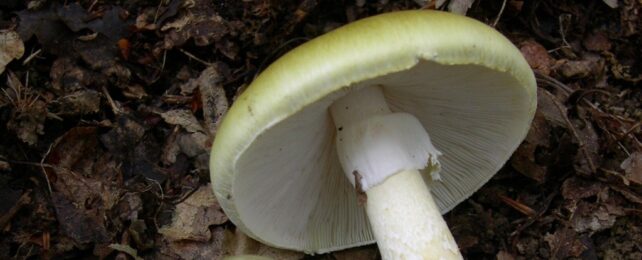In spite of being responsible for over 90 percent of mushroom-related fatalities around the world, we still don't know why the death cap mushroom is as lethal as it is. Which makes it a little difficult to discover ways to prevent its toxic effects.
Fortunately, scientists may have now identified a substance that could work as an antidote for poisoning by the famously deadly mushroom, Amanita phalloides. In even better news, the candidate, called indocyanine green, is already FDA approved and used as a dye for medical diagnostic imaging.
A research team led by chemists Guohui Wan and Qiaoping Wang of Sun Yat-sen University in China has now shown the chemical can reduce the potency of the main death cap toxin, α-amanitin, in human cell lines and mice, effectively blocking α-amanitin-induced cell death.
Death cap mushrooms are the reason you don't just go eating any old fungus you might pick in the forest. Originally native to Europe, they can now be found around the world. Attractive and bearing a strong resemblance to other, edible species of mushrooms, they're often picked and eaten by mistake.
With no clear signs of toxicity in their taste, and a slow manifestation of symptoms, it's far too easy to swallow a lethal dose. A few hours after eating, the patient might experience gastrointestinal symptoms that clear up after a day or two, giving the false impression that everything is fine.
Everything is not fine. From the time of ingestion, the mushroom's toxins eat away at the liver, producing symptoms that indicate serious damage to the organ. Without medical intervention – and in some cases, even with acute care – death cap mushroom toxins can result in failure of the liver, and sometimes kidneys, often leading to death. They're not called nice day for a picnic mushrooms, are they?
To get to the bottom of the toxicity of this particular fungus, the researchers took a multi-step approach. First, they used genome-wide CRISPR screening on the human cell line HAP1 to probe the destructive impact of α-amanitin. This technique identifies genes that work together by breaking them and looking for changes, which can highlight pathways in cells that are likely to be influenced by a toxin. In 2019, for example, it allowed scientists to identify the molecular mechanisms of box jellyfish venom, and develop a means of interfering with its meddling.
When the team conducted this screening on α-amanitin, they found the biosynthesis of proteins called N-glycans played a significant role in the cell death induced by the toxin. Further digging revealed that an enzyme called STT3B, which is required for the synthesis of N-glycans, seemed key to α-amanitin's toxicity.
Next, they screened substances already approved by the FDA for antidote candidates. They identified a potential inhibitor of STT3B – indocyanine green.
The only thing that remained was to test their findings. These tests were conducted on multiple lines of inquiry, including both human and mouse. Two different human cell lines – HAP1 and Hep G2 – were much more resistant to α-amanitin-induced cell death when pre-treated with indocyanine green.
Next, mouse liver organoids were treated. They, too, showed greater resistance to cell death.
Finally, the researchers tested live mice. These were injected with the toxin, and then treated with indocyanine green 4 hours later to mimic the likely treatment scenario for poisoned humans, while the researchers monitored their organs. The treated mice had less organ damage and cell death, and higher survivability, than untreated controls.
However, treatment with indocyanine green at intervals of 8 and 12 hours after poisoning lost its treatment effect, suggesting that irreversible damage occurs early, and that treatment for death cap mushroom poisoning needs to be sought as early as possible.
Further research needs to be conducted to determine how indocyanine green inhibits α-amanitin, and assess how safe it is to administer to humans, but these early results are promising for an antidote in the not-too-distant future.
"Overall," the researchers write, "we show that by coupling whole-genome functional genomic characterization with in silico drug prediction, we can rapidly define and then target medically relevant processes."
You can read more about identifying death cap mushrooms here, but if in any doubt whatsoever, it's safest just not to eat the fungus you found on the forest floor.
The results have been published in Nature Communications.
